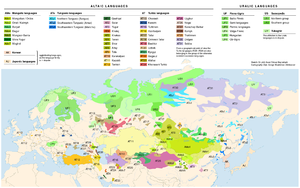Ural-Altaic languages
| Ural–Altaic | |
|---|---|
| (obsolete) | |
| Geographic distribution |
Eurasia |
| Linguistic classification | Proposed language family |
| Subdivisions | |
| Glottolog | None |

Distribution of Uralic, Altaic, and Yukaghir languages
|
|
Ural–Altaic, Uralo-Altaic or Uraltaic, also known as Turanian, is an obsolete language-family proposal uniting the Uralic and Altaic languages.
Originally suggested in the 19th century, the hypothesis remained debated into the mid 20th century, often with disagreements exacerbated by pan-nationalist agendas, enjoyed its greatest popularity by the proponents in Britain. Since the 1960s, the hypothesis has been widely rejected. From the 1990s, interest in a relationship between the Altaic, Indo-European and Uralic families has been revived in the context of the Eurasiatic linguistic superfamily hypothesis. Bomhard (2008) treats Uralic, Altaic and Indo-European as Eurasiatic daughter groups on equal footing.
In a book published in 1730, Philip Johan von Strahlenberg, Swedish explorer and prisoner-of-war in Siberia, described Finno-Ugric, Turkic, Samoyedic, Mongolic, Tungusic and Caucasian peoples as sharing commonalities. 20th century scholarship has on several occasions incorrectly credited him with proposing a Ural-Altaic language family, though he does not claim linguistic affinity between any of the six groups.
Danish philologist Rasmus Christian Rask described what he vaguely called "Scythian" languages in 1834, which included Finno-Ugric, Turkic, Samoyedic, Eskimo, Caucasian, Basque and others.
The hypothesis was elaborated at least as early as 1836 by W. Schott and in 1838 by F. J. Wiedemann.
The "Altaic" hypothesis, as mentioned by Finnish linguist and explorer Matthias Castrén by 1844, included Finno-Ugric and Samoyedic, collectively known as "Chudic", and Turkic, Mongolic, and Tungusic, collectively known as "Tataric". Subsequently, Turkic, Mongolic, and Tungusic came to be referred to as Altaic languages, whereas Finno-Ugric and Samoyedic were called Uralic. The similarities between these two families led to their retention in a common grouping, named Ural–Altaic.
...
Wikipedia
